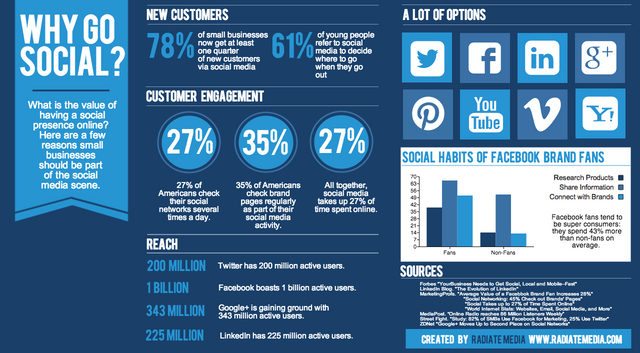Social Media Marketing
Open Access to Information
The Social Feedback Cycle is important to understand because it forms the basis of
social business. What the social feedback loop really represents is the way in which
Internet-based publishing and social technology has connected people around business
or business-like activities. This new social connectivity applies between a business and
its customers (B2C), between other businesses (B2B), between customers themselves,
as is the case in support communities and similar social applications, and just as well
between employees.
As such, this more widespread sharing has exposed information more broadly.
Information that previously was available to only a selected or privileged class of individuals
is now open to all. Say you wanted information about a hotel or vacation rental
property: Unless you were lucky enough to have a friend within your personal social
circle with specific knowledge applicable to your planned vacation, you had to consult
a travel agent and basically accept whatever it was that you were told. Otherwise, you
faced a mountain of work doing research yourself rather than hoping blindly for a good
experience in some place you’d never been before. Prior to visible ratings systems—think
Yelp.com here—you could “ask around” but that was about it, and “around” generally
meant “nearby,” friends, family and perhaps colleagues
The travel agent, to continue with this example, may have had only limited
domain expertise, lacking a detailed knowledge of rental versus hotel properties, for
example. This knowledge, or lack of it, would be critical to properly advising you on a
choice between renting a vacation property and booking a hotel. Austin’s Homeaway,
which brings tens of thousands of rated and reviewed vacation properties within a click
of booking, has built an entire business around empowering consumers looking for
vacation rentals as an alternative to hotels and resorts, a market that itself only blossomed
post–Internet 1.0.
Even more to the point and beyond the issue of specific knowledge, an intermediary
in a transaction may or may not have your best interests in mind when making
purchase recommendations. The same certainly applies to a company or organization
wanting to sell you something. This has long been an issue—correctly or incorrectly—
that has dogged pharmaceutical and insurance sales: Is the recommendation based on
the needs of the customer, the incentive offered by the drug’s manufacturer or insurance
underwriter, or some combination? From the consumer’s perspective, the difference is
everything.
At Progressive Insurance, where I worked for a number of years as a Product
Manager, we implemented a direct-to-consumer insurance product as an alternative
to policies sold through agents. We created this product specifically for customers who
wanted to take personal control of their purchases. This made sense from Progressive’s
business perspective because the degree of trust that a customer has in the sales process
is critical to building a long-term trusted relationship with its insured customers. While
many insurance customers have solid and long-standing relationships with their agents, it
is also the case that many are seeking additional information, second opinions, and outright
self-empowered alternatives. This reality is now commonplace across a range of businesses,
and it is driven by the choice that easily accessible, web-based information brings.
Where information beyond what was provided to you at or around the point of
sale was relatively difficult to access only 10 years ago, it is now easy. Look no further
than the auto sales process for an indication of just how significant the impact of scalable,
connected self-publishing—ratings, blog posts, photo and video uploads—really
is. It is this access to information and the opinions and experiences of others, along
with the outright creation of new information by consumers who are inclined to rate,
review, and publish their own experiences that is driving the impact of social media
deeper into the organization.
Social Business: The Logical Extension
Social business follows right on the heels of the wave of interest and activity around social
media and its direct application to marketing: Social business is the logical extension of social technology throughout and across the business. Social business takes social concepts—
sharing, rating, reviewing, connecting, and collaborating—to all parts of the business.
From Customer Service to product design to the promotions team, social behaviors
and the development of internal knowledge communities that connect people and their
ideas can give rise to smoother and more efficient business processes. Social business—
viewed in this way—becomes more about change management than marketing. That’s a
big thought.
Take a step back: Social media marketing—properly practiced—seeks to engage
customers in the online social locations where they naturally spend time. By comparison,
social business picks up on what they are talking about and what they are
interested in and connects this back into the business where it can be processed and
used to create the next round of customer experiences and hence the next round of
conversations.

It’s important to understand the role of the customer—taken here to include anyone
“on the other side” of a business transaction: It might be a retail consumer, a business
customer, a donor for a nonprofit organization, or a voter in an election. What’s
common across all of these archetypes—and what matters in the context of social
business—is that each of them has access to information, in addition to whatever information
you put into the marketplace, that can support or refute the messages you’ve
spent time and money creating.
But, as we say, “Wait. There’s more.” Beyond the marketing messages, think as
well about suggestions for improvements or innovation that may originate with your
customers: As a result of an actual experience or interaction with your brand, product,
or service, your customers have specific information about your business processes and
probably an idea or two on how your business might serve them better in the future.
Consider the following, all of which are typical of the kinds of “outputs” a customer
or business partner may have formed after a transaction, and will quietly walk
away with unless you take specific steps to collect this information and feedback:
• Ideas for product or service innovation
• Early warning of problems or opportunities
• Awareness aids (testimonials)
• Market expansions (ideas for new product applications)
• Customer service tips that flow from users to users
• Public sentiment around legislative action, or lack of action
• Competitive threats or exposed weaknesses
This list, hardly exhaustive, is typical of the kinds of information that customers
have and often share amongst themselves—and would readily share with you if
asked. Ironically, this information rarely makes it all the way back to the product and
service policy designers where it would do some real good. Importantly, this may be information that you don’t have, information that precisely because you are so close to
your business you may never see. Collecting this information and systematically applying
it is in your best interest.
For example, someone may find that your software product doesn’t integrate
smoothly with a particular software application that this customer may also have
installed. How would you know? This information—and the ensuing pleas for help
expressed in online forums—is something you can collect through social analytics (tools
and processes). It can then be combined with the experiences of other customers, as well
as your own process and domain knowledge, to improve a particular customer experience
and then offered generally as a new solution. This new solution could then be shared—
through the same community and collaborative technologies—with your wider customer
base, raising your firm’s relative value to your customers in the process and strengthening
your relationship with the customers who initially experienced the problem.
The resultant sharing of information—publishing a video, or writing a
review—and its use inside the organization forms the stepping-off point from social
media marketing and social analytics into social business. From a purely marketing
perspective—as used here, meaning the MarCom/advertising/PR domain—this shared
consumer information can be very helpful in encouraging others to make a similar
purchase. It can enlighten a marketer as to which advertising claims are accepted and
which are rejected, helping that marketer tune the message. It can also create a bridge
to dialog with the customer—think about onsite product reviews or support forums—
so that marketers can understand in greater detail what is helping and what is not.
Prior to actually making process changes, this listening and information gathering—
treated in depth in Chapter 6, “Social Analytics, Metrics and Measurement”—falls
under the heading of “more information” and so drives a need for enhanced social analytics
tools to help make sense of it. It’s worth pursuing. Access to customer-provided
information means your product or service adapts faster. By sharing the resulting
improvement and innovations while giving your customers credit, your business gains
positive recognition.
Although customers can provide an invaluable source of information, you should
be aware of the impact anonymous—and often negative—comments can have. It is
imperative to understand the role of your customer as both a recipient and publisher of the
content that circulates on the Social Web. Is a specific voice within a conversation that is
relevant to you coming from an evangelist, a “neutral,” or a detractor? It is important that
you know. Is it coming from a competitor or disgruntled ex-employee? The same holds
true: You need to know, so that you can plan your response. While the overall trend on
the Social Web is away from anonymity and toward identity, it’s not a given—at least not
yet—that any specific identity has been verified. This means you need to dig deeper.
This persistent anonymity opens the door for “comment and rating abuse,” but
social media also provides for a general raising of the bar when it comes to establishing actual identity. More and more, people write comments in the hopes that they will be
recognized. With this growing interest and importance of actual identity, in addition
to marketplace knowledge, social business and the analytical tools that help you sort
through the identity issues are important to making sense of what is happening around
you on the Social Web. Later sections tie the topics of influencer identification and the
use of the “social graph,” the inner working of the linkages that connect people and
the status updates that tell you what they are doing now, into business formally. For
now, accept that identity isn’t always what it appears, but at the same time the majority
of customer comments left are done so for the dual purpose of letting you know what
happened—good or bad—and at the same time letting you know that it happened to
someone in particular. They signed their name because they want you (as a business) to
recognize them.

“As people take control over their data while spreading their Web presence,
they are not looking for privacy, but for recognition as individuals. This will
eventually change the whole world of advertising.”

Well hello there!
!originalworks
The @OriginalWorks BETA V2 bot has upvoted(0.5%) and checked this post!
Some similarity seems to be present here:
https://www.slideshare.net/AppLeap/smm-5722144
This is an early BETA version. If you cited this source, then ignore this message! Reply if you feel this is an error.